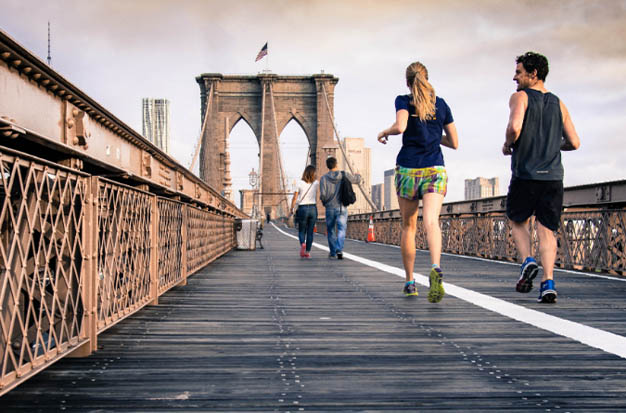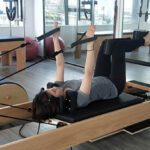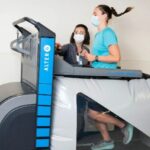How Might Regular Cardiorespiratory Exercise Affect Hypertension?

Blood pressure fluctuations are also known as blood pressure variability. Recent studies have shown that BPV is closely related to the structure and damage of target organs, as well as the course and outcome of cardiovascular disease. The study found that long-term, mid day and short-term systolic blood pressure fluctuations significantly increased all-cause mortality. In general, regular cardiovascular exercise can affect hypertension. So, what is the relationship between cardiovascular exercise and blood pressure fluctuation? Let’s analyze it now.
What Intensity of Cardiovascular Exercise Does Hypertension Adapt to?
People with persistent systolic blood pressure ≥ 140mmHg and / or diastolic blood pressure ≥ 90mmHg are considered as hypertension. Note: normal blood pressure is lower than 120/80mmhg, and 120-139/80-89mmhg is the normal high value. Patients with hypertension should participate in 30 minutes of moderate intensity dynamic aerobic exercise (such as walking, jogging, cycling, swimming) at least 5-7 days a week. This exercise intervention can reduce the systolic blood pressure by 7mmhg and the diastolic blood pressure by 5mmhg on average. And how to define their own medium intensity? For example, can jogging with the same speed and gradient be the same intensity for the elderly and young people? We need to conduct CPET cardiopulmonary exercise test to evaluate the body, and obtain relevant data based on the evaluation to determine the intensity. Additional resistance training is very effective in lowering blood pressure, and we also recommend to cooperate with further resistance training 2 to 3 days a week. In fact, the effect of resistance and isometric exercise on lowering blood pressure can be comparable to, or even better than, aerobic exercise.
Read More:
Stretching Exercises VS Cardio Exercises – Which Increases More Flexible?
Multiple Factors Affecting Blood Pressure
Previous studies have shown that many factors can cause blood pressure fluctuations. The first factor is gender and age. Generally speaking, the older the age, the greater the range of blood pressure fluctuation; The proportion of men with malignant hypertension was significantly higher than that of women; The second factor is temperature. The law is high temperature season, and blood pressure drops significantly; In cold season, blood pressure rises obviously; The third factor is the diurnal change. Blood pressure drops during sleep and rises after daytime activities; The fourth factor is emotion, anxiety and depression, especially when panic attacks, blood pressure will rise sharply; The fifth factor is lifestyle. For example, smoking and drinking can cause blood pressure to rise; For another example, eating too salty, too much sodium salt intake will also cause blood pressure to rise; The sixth factor is the influence of drugs. The relationship between cardiovascular exercise and blood pressure fluctuation has attracted the attention of many scholars. Athletes will have very strong blood pressure fluctuations when they bear the maximum activity. Researchers believe that this phenomenon is related to athletes’ long-term high-intensity exercise, resulting in physiological myocardial hypertrophy and increased adaptability of cardiac output.
How Regular Cardiorespiratory Exercise Affect Hypertension?
The study found that the left ventricular volume index was significantly higher in the people who insisted on a certain intensity of exercise. When bearing the daily exercise load, the fluctuation of blood pressure was smaller and the recovery of systolic blood pressure was faster. Therefore, scholars believe that long-term exercise is helpful to reduce blood pressure fluctuations. In other words, the amount of exercise and activity time at ordinary times are enough to help patients better control their blood pressure.
To understand the relationship between cardiovascular exercise and blood pressure fluctuation, there is another important concept, microvascular rarefaction. This concept refers to promoting the occurrence and development of target organ damage by increasing vascular resistance and improving microenvironment in hypertensive lesions. Studies have confirmed that moderate intensity exercise can help reduce blood pressure and improve vascular endothelial function. If the individualized exercise program is adopted, microvascular rarefaction can be improved. Moderate cardiorespiratory exercise can also help patients control blood glucose and lipids, reduce weight, and reduce the negative impact of obesity on blood pressure control. Moreover, exercise can improve sleep and help patients with hypertension relieve mental stress.
To reduce blood pressure fluctuation through cardiorespiratory exercise, it is necessary to fully consider the individual situation of patients. For people without other diseases but with high blood pressure, they can choose moderate intensity exercise; For the elderly, if the blood pressure is not well controlled, the systolic blood pressure exceeds 180mmhg, or the diastolic blood pressure exceeds 110 mmHg, it is not appropriate to carry out moderate intensity cardiorespiratory exercise; If you have other chronic diseases at the same time, you need to carry out relevant examinations. For example, if there is heart failure, you should first do a tablet test and other examinations to understand the endurance of the heart to the exercise load, and then carry out physical activities within your ability according to the recommendations of the standardized exercise prescription.
Pre Exercise Recommendations for Individuals with Hypertension
When patients with hypertension undergo cardiorespiratory exercise, they should gradually increase the amount of exercise, and judge whether the amount of exercise has reached medium intensity according to their personal feelings. For example, whether the heart beats faster, feels a little tired, and starts to sweat slightly during cardiorespiratory exercise; Wheezing occurs during exercise, and the respiratory rate increases; Walking speed reaches about 120 steps per minute; If we wear electronic measuring equipment, we can calculate whether the fastest heart rate reaches 170 minus the value of age. After the exercise, the respiratory rate can be relieved in about 10 minutes, and the heart rate is close to returning to normal. If this is not the case, there may be excessive exercise intensity. For exercise mode, it is recommended to use aerobic exercise such as fast walking and jogging for 30 minutes each time; At the same time, we should also pay attention to increasing muscle strength training and flexibility training.
If we need high-intensity cardiovascular exercise, it is necessary to conduct a pre participation cardiovascular assessment to determine whether athletes have exercise-induced symptoms, excessive blood pressure response and whether there is target organ damage caused by hypertension.
Individuals with symptoms indicating coronary artery disease need further evaluation and optimization of drug treatment before participating in exercise. If arterial hypertension is poorly controlled (resting systolic blood pressure > 160mmhg), the maximum (maximum load) exercise test should be postponed until the blood pressure is controlled.
When treating athletes’ hypertension, we should first consider taking non pharmacological measures, including limiting the intake of salt and alcohol, appropriately reducing weight if necessary, a balanced diet (such as the Mediterranean diet) and quitting smoking. Here, the aerobic exercise program should supplement the personal training program. If the change of lifestyle still fails to reduce blood pressure after 3 months, and the systolic blood pressure remains above 140 mmHg, antihypertensive drugs should be taken. Antihypertensive therapy and lifestyle intervention should be considered as long as they are well tolerated in people older than 65 but younger than 80.
It is important to consider that B-receptor blockers are banned in some competitive sports, such as shooting [see the complete list provided by the World Anti Doping Association (WADA)] , which can lead to bradycardia and / or reduce aerobic ability. Diuretics are banned in all competitive sports. Angiotensin converting enzyme (ACE) inhibitors, angiotensin II receptor blockers, and calcium antagonists are the first choice for exercise individuals. It should be noted that the use of non selective NSAIDs in the treatment of musculoskeletal pain may lead to an increase in blood pressure.
In case of poor blood pressure control, it is suggested to temporarily restrict participation in competitive sports, with the possible exception of skills. In high-risk groups, including those with final organ damage [left ventricular hypertrophy, diastolic dysfunction, ultrasonic evidence of arterial wall thickening or atherosclerotic plaque, hypertensive retinopathy, increased serum creatinine (1.3-1.5mg/dl in men, 1.2-1.4mg/dl in women), and / or microalbuminuria] . It is possible for people whose blood pressure is under control to participate in all competitive sports activities, except for the most intensive strength classes, such as discus / javelin throwing, shot put and weightlifting.
During exercise participation, regular follow-up is recommended according to the severity and risk category of hypertension. For individuals whose blood pressure readings are close to the critical value, regular dynamic assessment of blood pressure should be considered. People with low and medium cardiovascular risk and well controlled blood pressure should not be restricted from participating in exercise. However, intensive heavy lifting, especially when a large number of isometric (static) muscles are involved in work, may produce obvious stress effects, which should be avoided. In this case, it is necessary to avoid Valsalva action (which can be understood as holding your breath when exerting force temporarily), because the rise of systolic and diastolic blood pressure is related to holding your breath during muscle contraction. When the training is correctly performed, the high-intensity dynamic resistance training (up to 80% of 1 RM, less repetition times: n < 10) will not cause greater blood pressure rise than the low-intensity dynamic resistance training (< 50%1 RM, higher repetition times: n ≥ 20).
Some people with normal resting blood pressure will overreact to their blood pressure during exercise. High blood pressure response during exercise will increase the risk of hypertension in the future. In the exercise test, if the systolic blood pressure rises to >200mmhg when the work load is 100W, even if the athletes’ blood pressure is normal at rest, antihypertensive drug treatment and clinical evaluation, including ECG and echocardiography, should also be considered. In addition, in the treadmill exercise test of young Olympic athletes, the peak systolic blood pressure of men >220mmhg/ women >200 mmHg exceeded 95%.
Sometimes your throat muscles may feel anxious after exercise, then read this post: How to Relax Throat Muscles
How to judge whether there is enough cardiorespiratory exercise?
The amount of exercise recommended by the American Heart Association is: a total of not less than 150 minutes per week, that is, two and a half hours of moderate intensity exercise; Or a total of 75 minutes of high-intensity exercise; The combination of medium strength and high strength is also acceptable. For a week, try to maintain at least a total of 30 minutes of aerobic exercise every day. You can measure your exercise intensity according to your heart rate, generally 75% – 80% of the maximum heart rate (220 – age). Or based on our own feelings, that is, we can still talk with people during exercise, but it is not difficult. Do what you can, safety first
- It is important to make a plan based on medical advice, and to conduct a physical evaluation and seek medical advice before making an exercise plan. Hypertension is accompanied by the following conditions, so you need to consult your doctor: overweight or obese; Suffering from acute and chronic diseases with cardiopulmonary diseases; Chest discomfort or dizziness when walking; Close relatives had heart disease before the age of 55; Taking other drugs; Smoking; Unsure about your physical condition.
- Avoid two blood pressure peaks. Try to avoid two blood pressure peaks during exercise. One is the first few hours after waking up (6-9 a.m.) and the other is 4-6 p.m. Especially in the morning, when the incidence of cardiovascular and cerebrovascular diseases is the highest, it needs to be avoided. We can monitor our blood pressure at multiple time points in the day and choose an appropriate time period for exercise.
- Moderately control the exercise intensity. The exercise intensity should be appropriate. Each exercise intensity should be maintained for several days or 1 – 2 weeks before gradually increasing the exercise intensity. Breathing should be natural and easy during the whole exercise, especially during weight training. You can’t hold your breath, which will lead to a sudden rise in blood pressure.
- Monitor blood pressure changes measure blood pressure before exercise to avoid exercise when blood pressure is too high. Monitor blood pressure changes at least 1 hour after exercise.
- Pay attention to the prevention of sports injury. Pay attention to the correct posture to avoid sports injury. Warm up before exercise and relax after exercise.
- In case of any accident, stop the exercise in time. In case of the following conditions during the exercise, stop the exercise in time and seek the help of a doctor nearby: chest pain or tightness, dizziness or fainting, arm or jaw pain, obvious asthma, irregular heartbeat and excessive fatigue. Cardiorespiratory exercise is a protracted battle. The cultivation of a good habit requires at least a period of persistence. For young patients with hypertension, cardiorespiratory exercise should not be greedy for more and faster at the beginning. You can choose the easiest jogging or fast walking as the starting point. After forming a habit, you can gradually add more abundant exercise methods. Maintaining an ideal blood pressure state is a long-term process. Only by developing good exercise habits and adhering to cardiorespiratory exercise can we maintain the stability of blood pressure. If you stop exercising for two weeks, your physical strength will begin to decline; After stopping for several months, the effect of cardiovascular exercise on blood pressure control will also disappear. Finally, we should remind you that hypertension is a disease of comprehensive prevention and treatment. We should not only start with regular exercise, but also pay attention to the balance of diet and nutrition and psychological counseling. Combined with necessary drug treatment, young people must have the faith and perseverance to control hypertension for long-term health.
What Should We Pay Attention to in Regular Cardiovascular Exercise?
Cardiorespiratory exercise is one of the simple and effective methods to control blood pressure. In combination with other lifestyle interventions and antihypertensive drug therapy, it can control blood pressure well and reduce complications. The exercise of patients with hypertension should focus on ways and methods, and exercise in a scientific and regular manner. If we are unscientific, we will not only not be able to reduce blood pressure, but may also cause an increase in blood pressure and increase the incidence of cardiovascular and cerebrovascular accidents and other complications.
Cardiorespiratory exercise has multiple effects. When we exercise moderately and regularly for a long time, it can help us improve our cardiopulmonary function, reduce our anxiety, improve our vagus nerve excitability, and then reduce our heart rate. It can also help us control our weight and lose weight. It plays a good auxiliary role in reducing blood pressure and complications. We recommend that patients with hypertension exercise for more than half an hour a day for 5 to 7 days a week. We recommend that they choose moderate aerobic exercise, such as jogging, aerobics, Taijiquan, swimming, cycling, and other anti resistance exercises, such as lifting dumbbells and levers. Exercise should be gradual and avoid excessive vigorous exercise.
Before and after exercise, patients with hypertension should pay attention to:
- ① Before cardiorespiratory exercise, pay attention to the measurement of blood pressure and the evaluation of the condition. If the blood pressure level is too high, fluctuates too much, or there are symptoms such as heart failure and angina pectoris, control the blood pressure and treat the basic diseases first;
- ② Cardiorespiratory exercise should be conducted in a warm afternoon or evening to avoid exercise in the morning or in cold, rainy and snowy weather, so as to avoid inducing cardiovascular and cerebrovascular accidents;
- ③ Warm up before cardiorespiratory exercise, keep warm and supplement moisture during exercise;
- ④ The intensity of exercise should be a little sweating, a little tiredness during exercise, a quick recovery after a short period of attention, and no discomfort after getting up the next day;
- ⑤ The center rate of cardiovascular exercise should be controlled within 60% ~ 70% of 220 age;
- ⑥ In case of any discomfort during exercise, stop immediately and seek medical treatment if necessary.
While exercising, we should also pay attention to improving other lifestyles, do a good job in low salt diet, quit smoking and limit alcohol, control weight, work and rest regularly and maintain a good attitude. We should also take drugs regularly under the guidance of doctors. Drugs should be individualized, and long-term preparations should be selected. When necessary, we should use drugs in combination to stabilize and control blood pressure, reduce complications, improve quality of life and improve prognosis.
Read More: How Many Exercises Per Workout Session
Conclusion
A good habit needs at least a period of persistence. Cardiorespiratory exercise should not be greedy for more and faster at the beginning. You can choose the easiest jogging or fast walking as the starting point. After you form a habit, you can gradually add more abundant exercise methods. At the same time, we should also pay attention to the balance of diet and nutrition and psychological counseling.
*Find More Muscle Relaxation Methods Here!
- How to Relax Your Tight Sphincter Muscle with Useful Tips
- How Often Should I Relax My Hair & How to Relax Hair
- How to Have a Relaxing Weekend – Enjoy Yourself
- How Long Do Muscle Relaxers Stay in Your System
- Do Muscle Relaxers Cause Weight Gain – Muscle Relaxers Side Effects
- Why Does My Fat Itch When I Exercise – Common Causes
- How to Reduce Your Tongue Tension – Simple Exercises
- How to Relax During Sports – Simple Sport Psychology Techniques
- How to Relax Your Facial Muscles in Easy Ways
- How to Relax Chest Muscles After Breast Augmentation?
- Can a Chiropractor Prescribe Muscle Relaxers?
- Why Is My Waist Turning Bigger With Exercise?
- How Does Visualization Promote Relaxation and Stress Reduction?
- 5 Reasons Entrepreneurs Are Uncomfortable During Vacations
- How to Relax Throat Muscles Anxiety?
- How to Relax Your Jaw – The Best Ways to Relax Your Jaw









